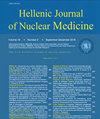骨单光子发射计算机断层扫描/计算机断层扫描鉴别胸锁关节炎阈值的临床价值。
IF 0.9
4区 医学
Q4 RADIOLOGY, NUCLEAR MEDICINE & MEDICAL IMAGING
引用次数: 0
摘要
目的随着单光子发射计算机断层摄影术(SPECT)/计算机断层摄影(CT)定量准确性的提高,骨SPECT/CT中使用标准化摄取值(SUV)进行定量评估的价值已被报道。我们建立了胸锁关节炎症和正常区域的阈值,并检查了骨SPECT/CT的临床价值。研究对象和方法初步计算了胸锁接头炎症和正常区之间的阈值。随后将计算出的阈值的诊断性能与全身图像的视觉评估进行比较。在视觉评估不明确的病例中检查阈值的临床价值,并对脓疱性关节炎(PAO)患者进行亚分析。结果51例患者的93个胸锁关节的炎症区与正常区之间的阈值为4.46。ROC曲线下面积(AUC)、SUVmax鉴别胸锁关节炎的准确性、敏感性和特异性分别为0.92、0.86、0.88和0.85。同样,视觉评估的AUC为0.87,差异不显著(P=0.11)。在25名PAO患者中,SUVmax的AUC、准确性、敏感性和特异性分别为0.94、0.90、0.96和0.84,视觉评估AUC显著更高(0.82,P=0.032),SUVmax的敏感性和特异性分别为0.84、1.00和0.71,这有助于判断治疗的开始。结论使用SUVmax和骨SPECT/CT阈值对胸锁关节炎的存在进行定量评估在临床上是有用的,并且可以作为开始治疗的有用工具,尤其是在PAO患者中。本文章由计算机程序翻译,如有差异,请以英文原文为准。
Clinical value of the threshold derived from bone single-photon emission computed tomography/computed tomography in differentiating sternoclavicular arthritis.
OBJECTIVE
With the recent improvements in the quantitative accuracy of single-photon emission computed tomography (SPECT)/ computed tomography (CT), the value of using standardized uptake value (SUV) in bone SPECT/CT for quantitative assessment has been reported.We established a threshold for inflamed and normal areas of the sternoclavicular joint and examined the clinical value of bone SPECT/CT.
SUBJECTS AND METHODS
The threshold between the inflamed and normal areas of the sternoclavicular joint was initially calculated. The diagnostic performance of the calculated threshold was subsequently compared with the visual assessment of the whole-body image. The clinical value of the threshold was examined in cases of ambiguous visual assessment and a sub-analysis with pustuloticarthro-osteitis (PAO) patients was done.
RESULTS
The threshold between the inflamed and the normal area in the 93 sternoclavicular joints of 51 patients was 4.46. The area under the ROC curve (AUC), accuracy, sensitivity, and specificity of SUVmax for differentiating sternoclavicular arthritis were 0.92, 0.86, 0.88, and 0.85, respectively. Similarly, the AUC of visual assessment were 0.87, and the difference was not significant (P=0.11). In 25 patients with PAO, the AUC, accuracy, sensitivity, and specificity of SUVmax were 0.94, 0.90, 0.96, and 0.84, respectively with a significant higher AUC of visual assessment (0.82, P=0.032). Furthermore, for cases where there was ambiguous uptake upon visual assessment, the accuracy, sensitivity, and specificity of SUVmax were 0.84, 1.00, and 0.71, respectively, which was useful to judge regarding the initiation of treatment.
CONCLUSION
Quantitative assessment using SUVmax and the threshold found using bone SPECT/CT for the presence of sternoclavicular arthritis is clinically useful and can be a useful tool for the initiation of treatment, especially in PAO patients.
求助全文
通过发布文献求助,成功后即可免费获取论文全文。
去求助
来源期刊
CiteScore
1.40
自引率
6.70%
发文量
34
审稿时长
>12 weeks
期刊介绍:
The Hellenic Journal of Nuclear Medicine published by the Hellenic Society of
Nuclear Medicine in Thessaloniki, aims to contribute to research, to education and
cover the scientific and professional interests of physicians, in the field of nuclear
medicine and in medicine in general. The journal may publish papers of nuclear
medicine and also papers that refer to related subjects as dosimetry, computer science,
targeting of gene expression, radioimmunoassay, radiation protection, biology, cell
trafficking, related historical brief reviews and other related subjects. Original papers
are preferred. The journal may after special agreement publish supplements covering
important subjects, dully reviewed and subscripted separately.

 求助内容:
求助内容: 应助结果提醒方式:
应助结果提醒方式:


